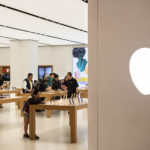Credder offers Rotten Tomatoes-style ratings for the news
In an age of online misinformation and clickbait, how do you know whether a publication is trustworthy?
Startup Credder is trying to solve this problem with reviews from both journalists and regular readers. These reviews are then aggregated into an overall credibility score (or rather, scores, since the journalist and reader ratings are calculated separately). So when you encounter an article from a new publication, you can check their scores on Credder to get a sense of how credible they are.
Co-founder and CEO Chase Palmieri compared the site to movie review aggregator Rotten Tomatoes. It makes sense, then, that he’s enlisted former Rotten Tomatoes CEO Patrick Lee to his advisory board, along with journalist Gabriel Snyder and former Xobni CEO Jeff Bonforte.
Palmieri plans to open Credder to the general public later this month, and he’s already raised $750,000 in funding from Founder Institute CEO Adeo Ressi, Ira Ehrenpreis, the law firm Orrick, Herrington & Sutcliffe, Steve Bennet and others.
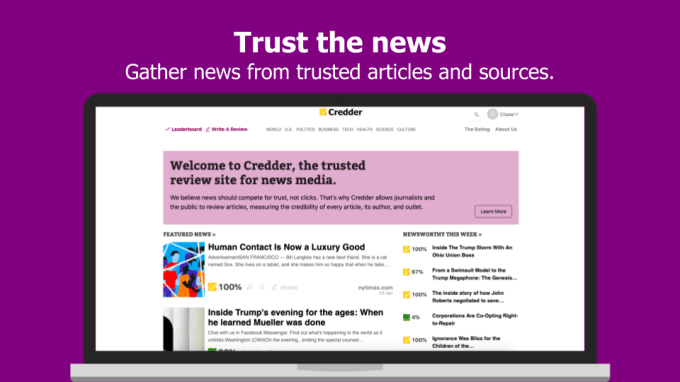
Palmieri told me he started working full-time on the project back in 2016, with the goal of “giving news consumers a way to productively hold the news producers accountable,” and to “realign the financial incentives of online media, so it’s not just rewarding clicks and traffic metrics.” In other words, he wanted to create a landscape where publishing empty clickbait or heavily slanted propaganda might have actual consequences.
If Credder gets much traction, it will likely attract its share of trolls — it’s easy to imagine that the same kind of person who leaves a negative review of “Captain Marvel” without seeing the movie (this is a real issue that Rotten Tomatoes has had to face), would be just as happy to smear The New York Times or CNN as “fake news.” And even if a reviewer is offering honest, good-faith feedback, the review might be less influenced by the quality of a publication’s journalism and more by their personal baggage or political leanings.
Palmieri acknowledged the risk and pointed to several ways Credder is trying to mitigate it. For one thing, users can’t just write an overall review of The New York Times or The Wall Street Journal or TechCrunch. Instead, they’re reviewing specific articles, so hopefully they’re engaging with the substance and specifics of the story, rather than just venting their preexisting feelings. The scores assigned to publications and to journalists are only generated when there are enough article ratings to create an aggregated score.
In addition, Palmieri said the reviewers “are also being held accountable,” because users can upvote or downvote their comments. That affects how the reviews get weighted in the overall score, and in turn generates a rating for the reviewers.
“It will take time for the weight of your reviews to be meaningful, and there will be a visible track record,” he said.
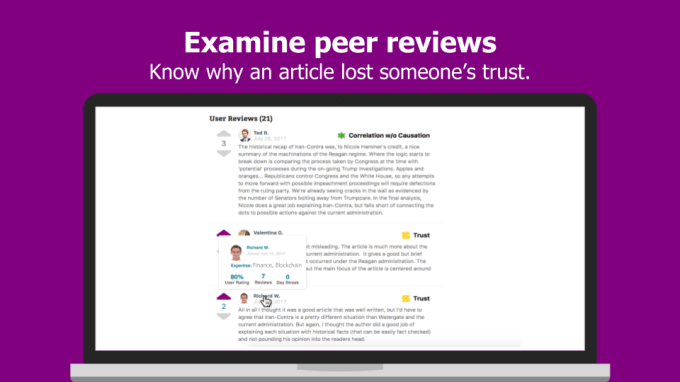
While I appreciated Palmieri’s vision, I was also skeptical that a credibility score can actually influence readers’ opinions — maybe it will matter when you encounter a new publication, but everyone already has set ideas about who they trust and don’t trust.
When I brought this up, Palmieri replied, “What we see in today’s media landscape is the left-wing media attacks the right-wing media, and vice versa. We never get a sense of what our fellow news consumers feel. What’s more likely to change your perspective and make you question yourself? It’s going to a rating page [for] an article, pointing out a specific problem in that article.”
To be clear, Credder isn’t hosting articles itself, simply crawling the web and creating rating pages for articles, publications and writers. As for making money, Palmieri said he’s considered both a tipping system and an ad system where publications can pay to promote their stories.
TechCrunch readers can check it out early by visiting the Credder website and using the promo code “TCNEWS”.
Powered by WPeMatico
Under the hood on Zoom’s IPO, with founder and CEO Eric Yuan
Extra Crunch offers members the opportunity to tune into conference calls led and moderated by the TechCrunch writers you read every day. This week, TechCrunch’s Kate Clark sat down with Eric Yuan, the founder and CEO of video communications startup Zoom, to go behind the curtain on the company’s recent IPO process and its path to the public markets.
Since hitting the trading desks just a few weeks ago, Zoom stock is up over 30%. But the Zoom’s path to becoming a Silicon Valley and Wall Street darling was anything but easy. Eric tells Kate how the company’s early focus on profitability, which is now helping drive the stock’s strong performance out of the gate, actually made it difficult to get VC money early on, and the company’s consistent focus on user experience led to organic growth across different customer bases.
Eric: I experienced the year 2000 dot com crash and the 2008 financial crisis, and it almost wiped out the company. I only got seed money from my friends, and also one or two VCs like AME Cloud Ventures and Qualcomm Ventures.
nd all other institutional VCs had no interest to invest in us. I was very paranoid and always thought “wow, we are not going to survive next week because we cannot raise the capital. And on the way, I thought we have to look into our own destiny. We wanted to be cash flow positive. We wanted to be profitable.
nd so by doing that, people thought I wasn’t as wise, because we’d probably be sacrificing growth, right? And a lot of other companies, they did very well and were not profitable because they focused on growth. And in the future they could be very, very profitable.

Eric and Kate also dive deeper into Zoom’s founding and Eric’s initial decision to leave WebEx to work on a better video communication solution. Eric also offers his take on what the future of video conferencing may look like in the next five to 10 years and gives advice to founders looking to build the next great company.
For access to the full transcription and the call audio, and for the opportunity to participate in future conference calls, become a member of Extra Crunch. Learn more and try it for free.
Kate Clark: Well thanks for joining us Eric.
Eric Yuan: No problem, no problem.
Kate: Super excited to chat about Zoom’s historic IPO. Before we jump into questions, I’m just going to review some of the key events leading up to the IPO, just to give some context to any of the listeners on the call.
Powered by WPeMatico
At this point, SoftBank Group is really just its Vision Fund
Last week, SoftBank Group Corp. — Masayoshi Son’s holding company for his rapidly expanding collection of businesses — reported its fiscal year financials. There were some major headlines that came out of the news, including that the company’s Vision Fund appears to be doing quite well and that SoftBank intends to increase its stake in Yahoo Japan.
Now that the dust has settled a bit, I wanted to dive into all 80 pages of the full financial results to see what else we can learn about the conglomerate’s strategy and future.
The Vision Fund is just dominating the financials
We talk incessantly about the Vision Fund here at TechCrunch, mostly because the fund seems to be investing in every startup that generates revenue and walks up and down Sand Hill looking for capital. During the last fiscal year ending March 31st, the fund added 36 new investments and reached 69 active holdings. The total invested capital was a staggering $60.1 billion.
Powered by WPeMatico
The state of the smartphone
Earlier this month, Canalys used the word “freefall” to describe its latest reporting. Global shipments fell 6.8% year over year. At 313.9 million, they were at their lowest level in nearly half a decade.
Of the major players, Apple was easily the hardest hit, falling 23.2% year over year. The firm says that’s the “largest single-quarter decline in the history of the iPhone.” And it’s not an anomaly, either. It’s part of a continued slide for the company, seen most recently in its Q1 earnings, which found the handset once again missing Wall Street expectations. That came on the tail of a quarter in which Apple announced it would no longer be reporting sales figures.
Tim Cook has placed much of the iPhone’s slide at the feet of a disappointing Chinese market. It’s been a tough nut for the company to crack, in part due to a slowing national economy. But there’s more to it than that. Trade tensions and increasing tariffs have certainly played a role — and things look like they’ll be getting worse before they get better on that front, with a recent bump from a 10 to 25% tariff bump on $60 billion in U.S. goods.
It’s important to keep in mind here that many handsets, regardless of country of origin, contain both Chinese and American components. On the U.S. side of the equation, that includes nearly ubiquitous elements like Qualcomm processors and a Google-designed operating system. But the causes of a stagnating (and now declining) smartphone market date back well before the current administration began sowing the seeds of a trade war with China.
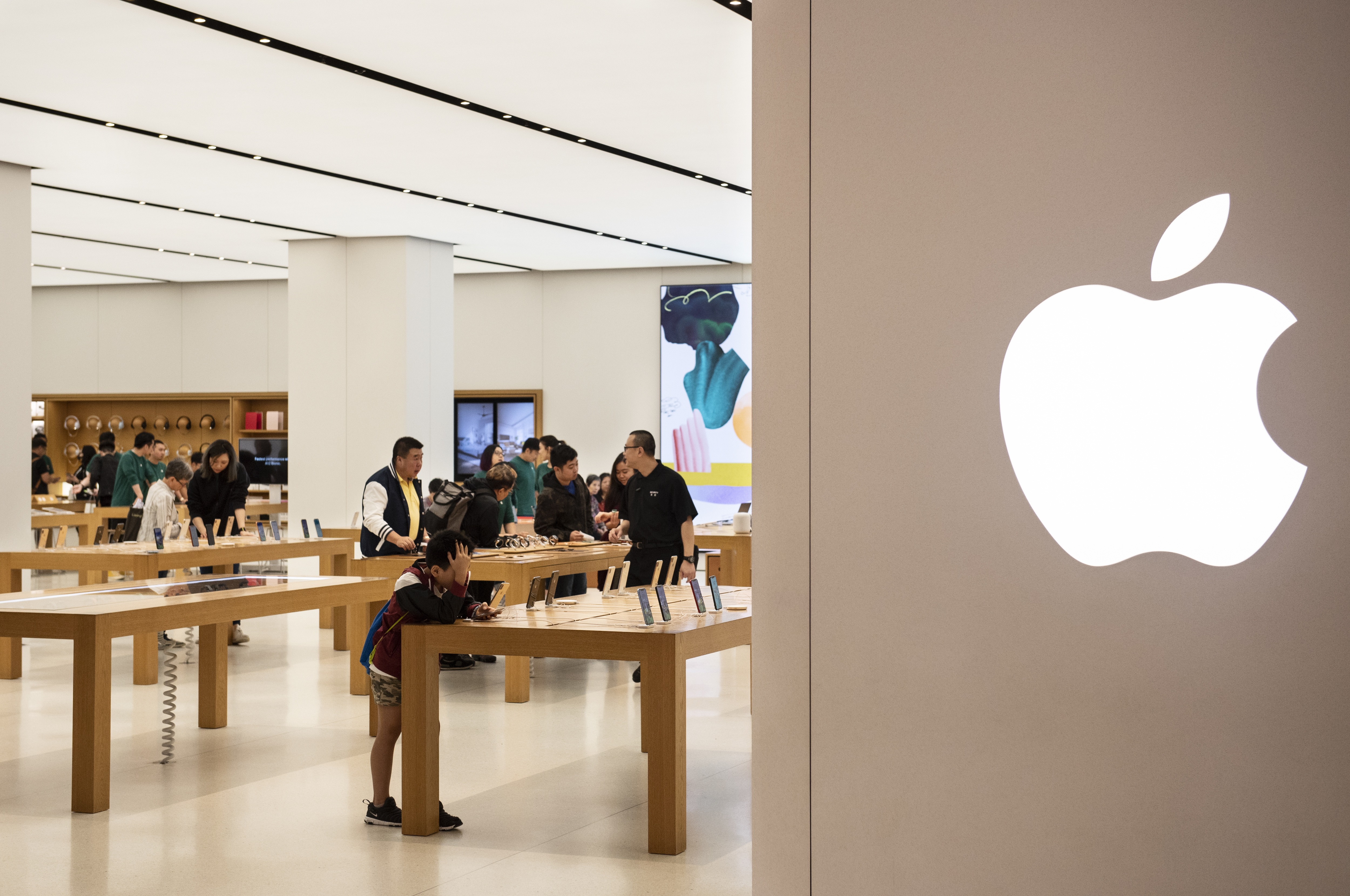
Image via Miguel Candela/SOPA Images/LightRocket via Getty Images
The underlying factors are many. For one thing, smartphones simply may be too good. It’s an odd notion, but an intense battle between premium phone manufacturers may have resulted in handsets that are simply too good to warrant the long-standing two-year upgrade cycle. NPD Executive Director Brad Akyuz tells TechCrunch that the average smartphone flagship user tends to hold onto their phones for around 30 months — or exactly two-and-a-half years.
That’s a pretty dramatic change from the days when smartphone purchases were driven almost exclusively by contracts. Smartphone upgrades here in the States were driven by the standard 24-month contract cycle. When one lapsed, it seemed all but a given that the customer would purchase the latest version of the heavily subsidized contract.
But as smartphone build quality has increased, so too have prices, as manufacturers have raised margins in order to offset declining sales volume. “All of a sudden, these devices became more expensive, and you can see that average selling price trend going through the roof,” says Akyuz. “It’s been crazy, especially on the high end.”
Powered by WPeMatico
HPE is buying Cray for $1.3 billion
HPE announced it was buying Cray for $1.3 billion, giving it access to the company’s high-performance computing portfolio, and perhaps a foothold into quantum computing in the future.
The purchase price was $35 a share, a $5.19 premium over yesterday’s close of $29.81 a share. Cray was founded in the 1970s and for a time represented the cutting edge of super computing in the United States, but times have changed, and as the market has shifted, a deal like this makes sense.
Ray Wang, founder and principal analyst at Constellation Research, says this is about consolidation at the high end of the market. “This is a smart acquisition for HPE. Cray has been losing money for some time but had a great portfolio of IP and patents that is key for the quantum era,” he told TechCrunch.
While HPE’s president and CEO Antonio Neri didn’t see it in those terms, he did see an opportunity in combining the two organizations. “By combining our world-class teams and technology, we will have the opportunity to drive the next generation of high performance computing and play an important part in advancing the way people live and work,” he said in a statement.
Cray CEO and president Peter Ungaro agreed. “We believe that the combination of Cray and HPE creates an industry leader in the fast-growing High-Performance Computing (HPC) and AI markets and creates a number of opportunities that neither company would likely be able to capture on their own,” he wrote in a blog post announcing the deal.
Patrick Moorhead, principal analyst at Moor Insights & Strategy says HPC is one of the fastest growing markets and HPE has indicated it wants to stake a claim there. “I’m not surprised by the deal. Its degree of success will be determined by the integration of the two companies. HPE brings increased scale and some unique consumption models and Cray brings expertise and unique connectivity IP,” Moorhead explained.
While it’s not clear how this will work over time, this type of consolidation usually involves some job loss on the operations side of the house as the two companies become one. It is also unclear how this will affect Cray’s customers as it moves to become part of HPE, but HPE has plans to create a high-performance computing product family using its new assets in combination with the new Cray products.
HPE was formed when HP split into two companies in 2014. HP Inc. is the printer division, while HPE is the enterprise side.
The deal is subject to the typical regulatory oversight, but if all goes well, it is expected to close in HPE’s fiscal Q1 2020.
Powered by WPeMatico
Minecraft Earth makes the whole real world your very own blocky realm
When your game tops 100 million players, your thoughts naturally turn to doubling that number. That’s the case with the creators, or rather stewards, of Minecraft at Microsoft, where the game has become a product category unto itself. And now it is making its biggest leap yet — to a real-world augmented reality game in the vein of Pokémon GO, called Minecraft Earth.
Announced today but not playable until summer (on iOS and Android) or later, MCE (as I’ll call it) is full-on Minecraft, reimagined to be mobile and AR-first. So what is it? As executive producer Jesse Merriam put it succinctly: “Everywhere you go, you see Minecraft. And everywhere you go, you can play Minecraft.”
Yes, yes — but what is it? Less succinctly put, MCE is like other real-world-based AR games in that it lets you travel around a virtual version of your area, collecting items and participating in mini-games. Where it’s unlike other such games is that it’s built on top of Minecraft: Bedrock Edition, meaning it’s not some offshoot or mobile cash-in; this is straight-up Minecraft, with all the blocks, monsters and redstone switches you desire, but in AR format. You collect stuff so you can build with it and share your tiny, blocky worlds with friends.
That introduces some fun opportunities and a few non-trivial limitations. Let’s run down what MCE looks like — verbally, at least, as Microsoft is being exceedingly stingy with real in-game assets.
There’s a map, of course
Because it’s Minecraft Earth, you’ll inhabit a special Minecraftified version of the real world, just as Pokémon GO and Harry Potter: Wizards Unite put a layer atop existing streets and landmarks.
The look is blocky to be sure, but not so far off the normal look that you won’t recognize it. It uses OpenStreetMaps data, including annotated and inferred information about districts, private property, safe and unsafe places and so on — which will be important later.
The fantasy map is filled with things to tap on, unsurprisingly called tappables. These can be a number of things: resources in the form of treasure chests, mobs and adventures.
Chests are filled with blocks, naturally, adding to your reserves of cobblestone, brick and so on, all the different varieties appearing with appropriate rarity.
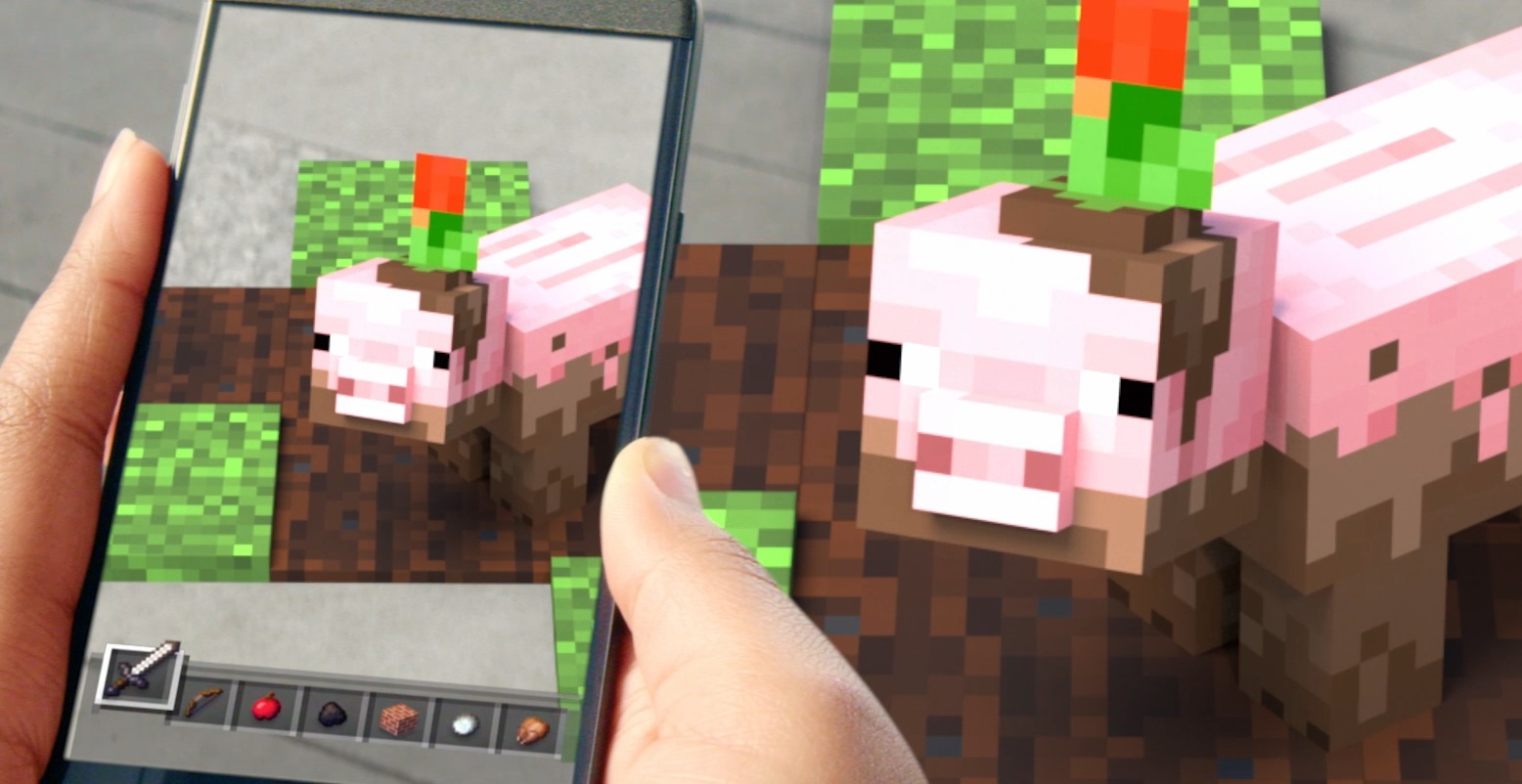 Mobs are animals like those you might normally run across in the Minecraft wilderness: pigs, chickens, squid and so on. You snag them like items, and they too have rarities, and not just cosmetic ones. The team highlighted a favorite of theirs, the muddy pig, which when placed down will stop at nothing to get to mud and never wants to leave, or a cave chicken that lays mushrooms instead of eggs. Yes, you can breed them.
Mobs are animals like those you might normally run across in the Minecraft wilderness: pigs, chickens, squid and so on. You snag them like items, and they too have rarities, and not just cosmetic ones. The team highlighted a favorite of theirs, the muddy pig, which when placed down will stop at nothing to get to mud and never wants to leave, or a cave chicken that lays mushrooms instead of eggs. Yes, you can breed them.
Last are adventures, which are tiny AR instances that let you collect a resource, fight some monsters and so on. For example you might find a crack in the ground that, when mined, vomits forth a volume of lava you’ll have to get away from, and then inside the resulting cave are some skeletons guarding a treasure chest. The team said they’re designing a huge number of these encounters.
Importantly, all these things — chests, mobs and encounters — are shared between friends. If I see a chest, you see a chest — and the chest will have the same items. And in an AR encounter, all nearby players are brought in, and can contribute and collect the reward in shared fashion.
And it’s in these AR experiences and the “build plates” you’re doing it all for that the game really shines.
The AR part
“If you want to play Minecraft Earth without AR, you have to turn it off,” said Torfi Olafsson, the game’s director. This is not AR-optional, as with Niantic’s games. This is AR-native, and for good and ill the only way you can really play is by using your phone as a window into another world. Fortunately it works really well.
First, though, let me explain the whole build plate thing. You may have been wondering how these collectibles and mini-games amount to Minecraft. They don’t — they’re just the raw materials for it.
Whenever you feel like it, you can bring out what the team calls a build plate, which is a special item, a flat square that you virtually put down somewhere in the real world — on a surface like the table or floor, for instance — and it transforms into a small, but totally functional, Minecraft world.
In this little world you can build whatever you want, or dig into the ground, build an inverted palace for your cave chickens or create a paradise for your mud-loving pigs — whatever you want. Like Minecraft itself, each build plate is completely open-ended. Well, perhaps that’s the wrong phrase — they’re actually quite closely bounded, as the world only exists out to the edge of the plate. But they’re certainly yours to play with however you want.
Notably all the usual Minecraft rules are present — this isn’t Minecraft Lite, just a small game world. Water and lava flow how they should, blocks have all the qualities they should and mobs all act as they normally would.
The magic part comes when you find that you can instantly convert your build plate from miniature to life-size. Now the castle you’ve been building on the table is three stories tall in the park. Your pigs regard you silently as you walk through the halls and admire the care and attention to detail with which you no doubt assembled them. It really is a trip.
In the demo, I played with a few other members of the press; we got to experience a couple of build plates and adventures at life-size (technically actually 3/4 life size — the 1 block to 1 meter scale turned out to be a little daunting in testing). It was absolute chaos, really, everyone placing blocks and destroying them and flooding the area and putting down chickens. But it totally worked.
The system uses Microsoft’s new Azure Spatial Anchor system, which quickly and continuously fixed our locations in virtual space. It updated remarkably quickly, with no lag, showing the location and orientation of the other players in real time. Meanwhile the game world itself was rock-solid in space, smooth to enter and explore, and rarely bugging out (and that only in understandable circumstances). That’s great news considering how heavily the game leans on the multiplayer experience.
The team said they’d tested up to 10 players at once in an AR instance, and while there’s technically no limit, there’s sort of a physical limit in how many people can fit in the small space allocated to an adventure or around a tabletop. Don’t expect any giant 64-player raids, but do expect to take down hordes of spiders with three or four friends.
Pick(ax)ing their battles
In choosing to make the game the way they’ve made it, the team naturally created certain limitations and risks. You Wouldn’t want, for example, an adventure icon to pop up in the middle of the highway.
For exactly that reason the team spent a lot of work making the map metadata extremely robust. Adventures won’t spawn in areas like private residences or yards, though of course simple collectibles might. But because you’re able to reach things up to 70 meters away, it’s unlikely you’ll have to knock on someone’s door and say there’s a cave chicken in their pool and you’d like to touch it, please.
Furthermore adventures will not spawn in areas like streets or difficult to reach areas. The team said they worked very hard making it possible for the engine to recognize places that are not only publicly accessible, but safe and easy to access. Think sidewalks and parks.
Another limitation is that, as an AR game, you move around the real world. But in Minecraft, verticality is an important part of the gameplay. Unfortunately, the simple truth is that in the real world you can’t climb virtual stairs or descend into a virtual cave. You as a player exist on a 2D plane, and can interact with but not visit places above and below that plane. (An exception of course is on a build plate, where in miniature you can fly around it freely by moving your phone.)
That’s a shame for people who can’t move around easily, though you can pick up and rotate the build plate to access different sides. Weapons and tools also have infinite range, eliminating a potential barrier to fun and accessibility.
What will keep people playing?
In Pokémon GO, there’s the drive to catch ’em all. In Wizards Unite, you’ll want to advance the story and your skills. What’s the draw with Minecraft Earth? Well, what’s the draw in Minecraft? You can build stuff. And now you can build stuff in AR on your phone.
The game isn’t narrative-driven, and although there is some (unspecified) character progression, for the most part the focus is on just having fun doing and making stuff in Minecraft. Like a set of LEGO blocks, a build plate and your persistent inventory simply make for a lively sandbox.
Admittedly that doesn’t sound like it carries the same addictive draw of Pokémon, but the truth is Minecraft kind of breaks the rules like that. Millions of people play this game all the time just to make stuff and show that stuff to other people. Although you’ll be limited in how you can share to start, there will surely be ways to explore popular builds in the future.
And how will it make money? The team basically punted on that question — they’re fortunately in a position where they don’t have to worry about that yet. Minecraft is one of the biggest games of all time and a big money-maker — it’s probably worth the cost just to keep people engaged with the world and community.
MCE seems to me like a delightful thing, but one that must be appreciated on its own merits. A lack of screenshots and gameplay video isn’t doing a lot to help you here, I admit. Trust me when I say it looks great, plays well and seems fundamentally like a good time for all ages.
A few other stray facts I picked up:
- Regions will roll out gradually, but it will be available in all the same languages as Vanilla at launch
- Yes, there will be skins (and they’ll carry over from your existing account)
- There will be different sizes and types of build plates
- There’s crafting, but no 3×3 crafting grid (?!)
- You can report griefers and so on, but the way the game is structured it shouldn’t be an issue
- The AR engine creates and uses a point cloud but doesn’t, like, take pictures of your bedroom
- Content is added to the map dynamically, and there will be hot spots but emptier areas will fill up if you’re there
- It leverages AR Core and AR Kit, naturally
- The HoloLens version of Minecraft we saw a while back is a predecessor “more spiritually than technically”
- Adventures that could be scary to kids have a special sign
- “Friends” can steal blocks from your build plate if you’re playing together (or donate them)
Sound fun? Sign up for the beta here.
Powered by WPeMatico
Health at Scale lands $16M Series A to bring machine learning to healthcare
Health at Scale, a startup with founders who have both medical and engineering expertise, wants to bring machine learning to bear on healthcare treatment options to produce outcomes with better results and less aftercare. Today the company announced a $16 million Series A. Optum, which is part of the UnitedHealth Group, was the sole investor.
Today, when people look at treatment options, they may look at a particular surgeon or hospital, or simply what the insurance company will cover, but they typically lack the data to make truly informed decisions. This is true across every part of the healthcare system, particularly in the U.S. The company believes using machine learning, it can produce better results.
“We are a machine learning shop, and we focus on what I would describe as precision delivery. So in other words, we look at this question of how do we match patients to the right treatments, by the right providers, at the right time,” Zeeshan Syed, Health at Scale CEO told TechCrunch.
The founders see the current system as fundamentally flawed, and while they see their customers as insurance companies, hospital systems and self-insured employers, they say the tools they are putting into the system should help everyone in the loop get a better outcome.
The idea is to make treatment decisions more data-driven. While they aren’t sharing their data sources, they say they have information, from patients with a given condition, to doctors who treat that condition, to facilities where the treatment happens. By looking at a patient’s individual treatment needs and medical history, they believe they can do a better job of matching that person to the best doctor and hospital for the job. They say this will result in the fewest post-operative treatment requirements, whether that involves trips to the emergency room or time in a skilled nursing facility, all of which would end up adding significant additional cost.
If you’re thinking this is strictly about cost savings for these large institutions, Mohammed Saeed, who is the company’s chief medical officer and has an MD from Harvard and a PhD in electrical engineering from MIT, insists that isn’t the case. “From our perspective, it’s a win-win situation since we provide the best recommendations that have the patient interest at heart, but from a payer or provider perspective, when you have lower complication rates you have better outcomes and you lower your total cost of care long term,” he said.
The company says the solution is being used by large hospital systems and insurer customers, although it couldn’t share any. The founders also said it has studied the outcomes after using its software and the machine learning models have produced better outcomes, although it couldn’t provide the data to back that up at that point at this time.
The company was founded in 2015 and currently has 11 employees. It plans to use today’s funding to build out sales and marketing to bring the solution to a wider customer set.
Powered by WPeMatico
Steam Link now lets you beam Steam games to your iOS devices
About a year ago, Valve announced that it was building an application called Steam Link. It’d let you play Steam games built for Mac/Windows/Linux on your iOS or Android devices through the magic of streaming, with a computer on your local network doing all the actual heavy lifting.
Then Valve submitted it to the iOS App Store and… Apple rejected it. At the time, Valve said that Apple pinned the rejection on “business conflicts.”
A year later, it seems said conflicts have finally been resolved. Steam Link for iOS just hit the App Store.
Because there’s no way most PC games would be fun on a touchscreen, you’ll probably want a controller — Valve says that Made for iPhone-certified controllers should work, as will its own Steam-branded controller. The company also notes that for best performance, the computer doing the streaming should be hardwired to your router, and your iOS device should be running on your Wi-Fi network’s 5Ghz band.
Powered by WPeMatico
Asus’ $499 ZenFone 6 has a flip-up camera and a giant battery
Premium smartphone manufacturers have moved the needle on pricing, but 2019 may well go down as a kind of golden age for budget flagships. Apple, Google and Samsung are all in that business now, and OnePlus has once again shown the world how to offer more for less. And then there’s the new ZenFone.
It’s a bit of an understatement to suggest that Asus has had trouble breaking into the smartphone space. And things aren’t likely to get any easier as the market further consolidates among the top five players. But you’ve got to hand it to the company for swinging for the fences with the $499 ZenFone 6.
First thing’s first. Like the excellent OnePlus 7 Pro, the phone (fone?) forgoes the notch and hole punch, instead opting for a clever pop-up that flips up from the back. That means one camera is doing double duty, toggling between the front and rear with the push of an on-screen button. Like the OnePlus, there’s built-in fall detection that retracts the camera if it slips from your hand.
5000 > 1+7+3700, so why choose ordinary when you can #DefyOrdinary? #ZenFone6 pic.twitter.com/x8R24953mS
— ASUS (@ASUS) May 14, 2019
That whole dealie would be enough to help the phone stand out in a world of similar handsets, but this is a solid budget handset through and through. Inside is a bleeding-edge Snapdragon 855, coupled with a beefy 5,000 mAh battery. The new ZenFone also sports a headphone jack, because it’s 2019 and rules don’t apply to smartphones anymore.
Is that all enough to right the ship? Probably not, but it’s nice to see Asus stepping up with a compelling product at an even more compelling price point. More information on the phone’s U.S. release should be arriving soon.
Powered by WPeMatico
Retail Zipline raises $9.6M from Emergence and Serena Williams
Retail Zipline, a startup aiming to improve communication between retail stores and corporate decision makers, announced today that it has raised $9.6 million in Series A funding.
CEO Melissa Wong previously worked in corporate communications for Old Navy, where she said she saw “such a disconnect between what was decided in headquarters and what was decided in stores.” For example, management might decide on a big marketing push to sell any remaining Mother’s Day-related items after the holiday has passed, but then “the stores wouldn’t do it.”
“The stores would say there were too many messages, they didn’t see the memo, they didn’t know it was a priority,” Wong said.
So she founded Retail Zipline with CTO Jeremy Baker, with the goal of building better communication tools for retailers. Baker said that while they looked at existing chat and task management software for inspiration, those tools were “mostly built for people sitting at a desk all day,” rather than workers who are “on the floor, dealing with customers.”
Retail Zipline’s features include messaging and task management — plus a centralized library of documents and multimedia and a survey tool to track results and feedback from stores.
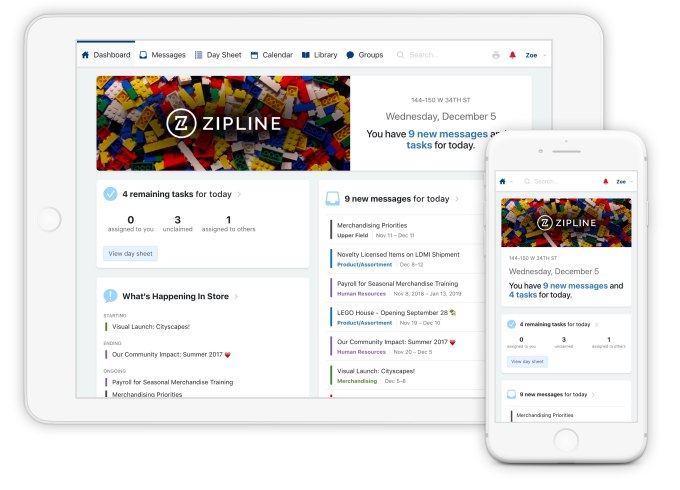
To illustrate how the software is actually being used, Baker outlined a scenario where an athletic shoe company is launching “a huge initiative,” with a big-name athlete signed on to promote the latest pair of shoes.
“In a traditional environment, someone might FedEx over a package to [the store], someone might send an email down, ‘Hey, look for a package on this day,’ someone else from the marketing team might say, ‘Hey guys, we’re doing a shoe launch,’ ” he said. “All of this in these disparate systems, where people have to piece together the story. It’s kind of like a murder mystery.”
Baker said that Retail Zipline, on the other hand, provides a single place to find all the needed materials and tasks “tied together with a bow, instead of a store manager spending 10-plus hours in the back room trying to piece this thing together, or even worse not seeing it.”
The company’s customers include Casper, LEGO and Lush Cosmetics. Wong said Retail Zipline works “with anyone that has a retail location” — ranging from Gap, Inc. with thousands of stores, to Toms Shoes with 10.
The funding was led by Emergence, with Santi Subotovsky and Kara Egan from Emergence both joining the startup’s board of directors. Serena Williams’ new firm Serena Ventures also participated.
“As someone with an incredibly active life, I understand the need to be dynamic, and capable of quickly adapting to shifting priorities, but I’m also aware of the stress a fast-paced work environment can impose,” Williams said in a statement. “Retail Zipline is tackling this issue head-on in retail – a notoriously stressful industry – by pioneering products that help store associates get organized, communicate efficiently, and deliver amazing customer experiences.”
Powered by WPeMatico

